As mentioned on the previous page, here is the genesis of the RCS/RI Millspace. A lot of work went into setting the initial collection into place.
Don't forget to check out Millspace Tour Page Two to see how it's grown, and some of the folks in our little coven.
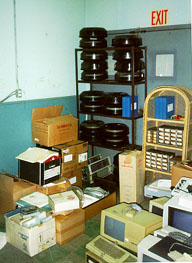 |
Library This is the media corner of the library. These boxes are full of paper and magnetic tape as well as other media not readily identifiable. Along the back is a tall shelf of MAI Basic Four disk packs. These seem to take up the most volume. Down and two the left is s shelf of little drawers, each containing paper punch tape. Also present are a multitude of technical drawings for the DEC machines and various miscellaneous documentation for scientific applications. By the time of this writing. The media collection, and library too, has tripled in size to accomodate media for various new acquisitions. Fortunately we now have some tables, filing cabinets and shelves to begin storing things properly. |
| Basic Four Computers These are MAI Basic Four business computers. Around the late 70's office computing was coming into demand and these pre-PC local network machines kept many techs busy. The Basic Four came bundled with accounting and word processing software in large disk packs (see below). The software apparently did have some third-party support, but the bundled software was complete for most businesses. These were still in operation by the late 80's. The terminals are very remniscent on the TRS-80 Model 3. |
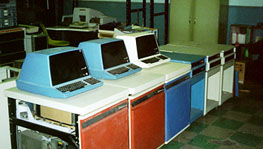 |
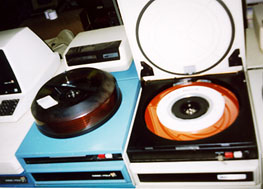 |
Basic Four Disk Packs About the diameter of an LP and the height of a cake holder. These large disk packs drop into the Basic Four after opening the top like a washing machine. Note the previous picture of the media room with a stack of these babies in the back. |
| Apple's Lisa This is part of Dave Fischer's personal collection. The Apple Lisa, a precursor to the modern Macintosh, is fully functional with only occasional problems. We're presently searching for some diagnostic/repair software for some of the minor problems. The Apple Lisa pictured here has many of the expected features of the early Macs. Calculator, notepad, zooming windows, icons, trash, hard drive icons and all. The hard drive sitting on top has 5 meg of memory and must spin up properly before turning the rest of the unit on. |
 |
Digital Flips Chips and PDP-11 Rack We are always glad to accept donations, we are constantly sifting through the pieces of our initial Rochester haul as well as new machines and parts that come in almost every week. First order of business was to organize all the extra Flip Chips for the PDPs so we had something to work with in restoring the vintage minis. Also here is a PDP-11 rack. Some components are missing or in one of the other 2 racks not pictured. |
| Various Components and Rack Here we have various line printers, microcomputers, knee-top computers and various terminals in different stages of operational ability. Being a fan of microcomputers, expect to see more information on these as I find time to sift through and work on each one. There will be a special Millspace Micro Page coming soon. Also here is a "junk" rack with various different components including a Teletype Line Test unit and a signal pre-amp. |
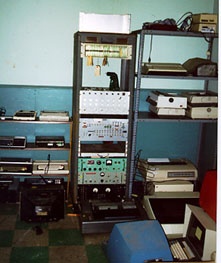 |
| Univac Card Punch/Reader This Univac card punch/reader seems to be in excellent condition. The tabletop is detachable and the keyboard is positionable. We also have several FLEXO-Writers and DECwriters in the collection. I also saw an Army issue-style IBM electric typewriter floating somewhere around the millspace. Someone also donated an old OCR scanner that had to be manually run line by line as the paper original sat in a Curtis-Clip style tray. |
| A Working PDP-12 This PDP-12 is functional. The video is fine, the blinkenlights are programmable and the tape drives are functional. In this picture the VT terminal is used for display and the small TRS-100 computer is being used as input. Carl has already done some work with the physical compenents through software testing and getting his hands dirty. While a Data General bigot, we appreciate his taking the time to endur the rigors of DEC. Dave has already done some original programming work on this as well. |
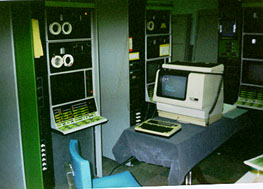 |
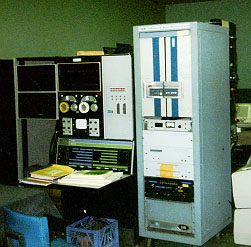 |
LINC-8 and PB250 Digital's LINC-8 and a big Packard-Bell 250 computer (circa 1961). The LINC has the detachable counter top by the various flip switches. The Packard-Bell 250 has some interesting-looking hardware, a serial number of 119 and has been operated for 60,742 hours (That's almost 7 years if run non-stop! Not bad for something this heavy and wirebound). Stands six feet, four inches. |
| LINC-8, Rear View This is a rear view of the LINC-8. Notice the rows of Flips Chips on the right and the heavy power supply boxes on the left. After placing this machine in the millspace, every Flip Chip had to re-checked and re-seated. We have some good close-ups of these, look for them soon. |
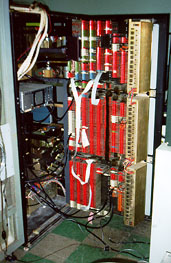 |
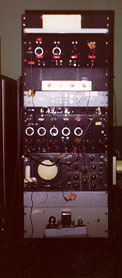 |
Laboratory Experiment Instrumentation Relay Rack This Laboratory Experiment Instrumentation relay rack contains I/O hardware to interface with the Packard Bell 250. Below the oscilloscope is an optical high speed paper tape reader which is considered fairly unusual for the time. Along the top are some i/o plugs and audio controls that are a bit reminiscent of an old stereo console. |
Move on to the Second Page
Go back to the Millspace Page
Go to Tumbleweed's Computer Shack
Go to Tumbleweed's Corner